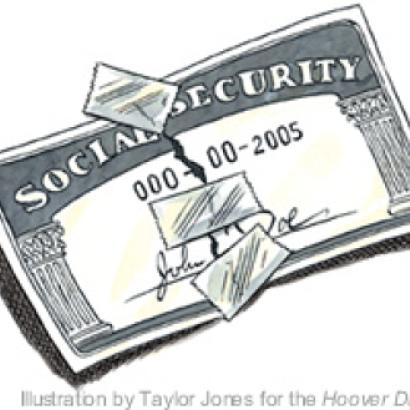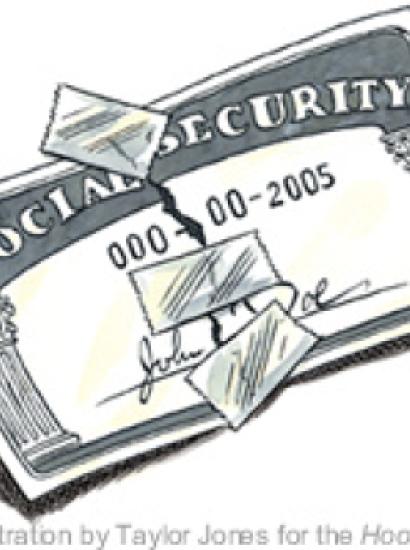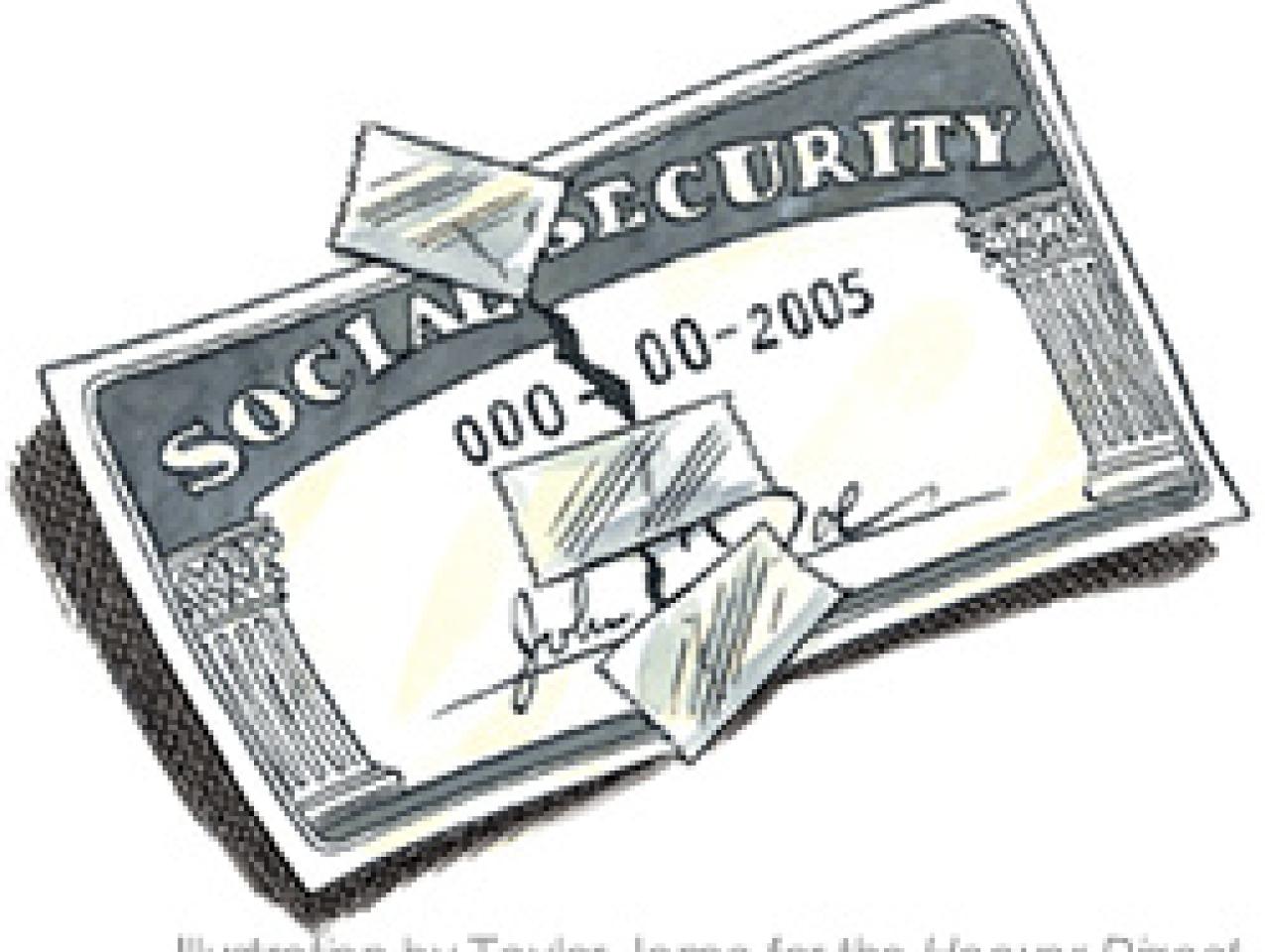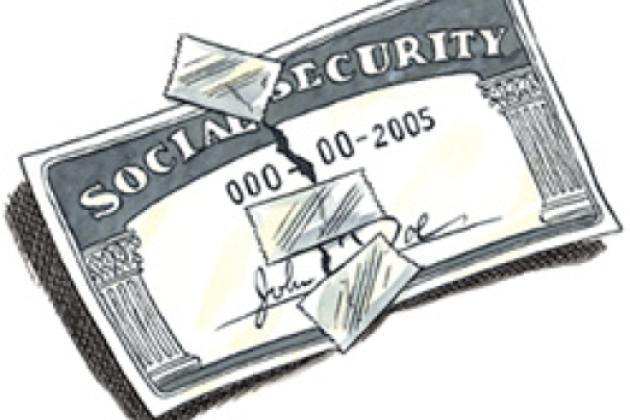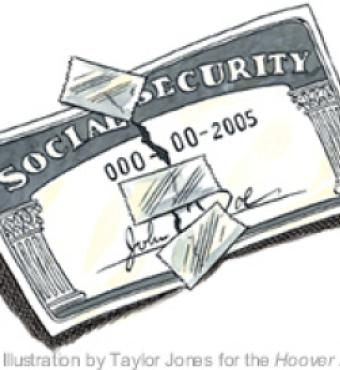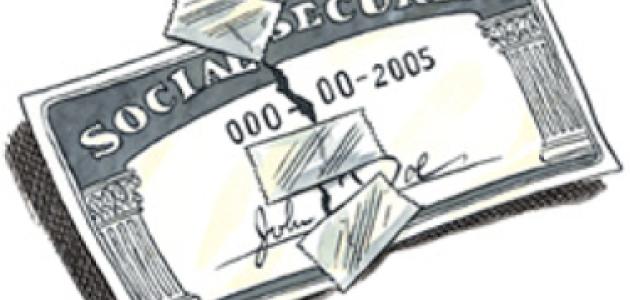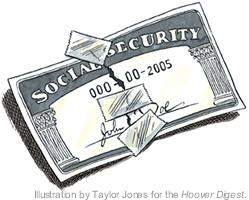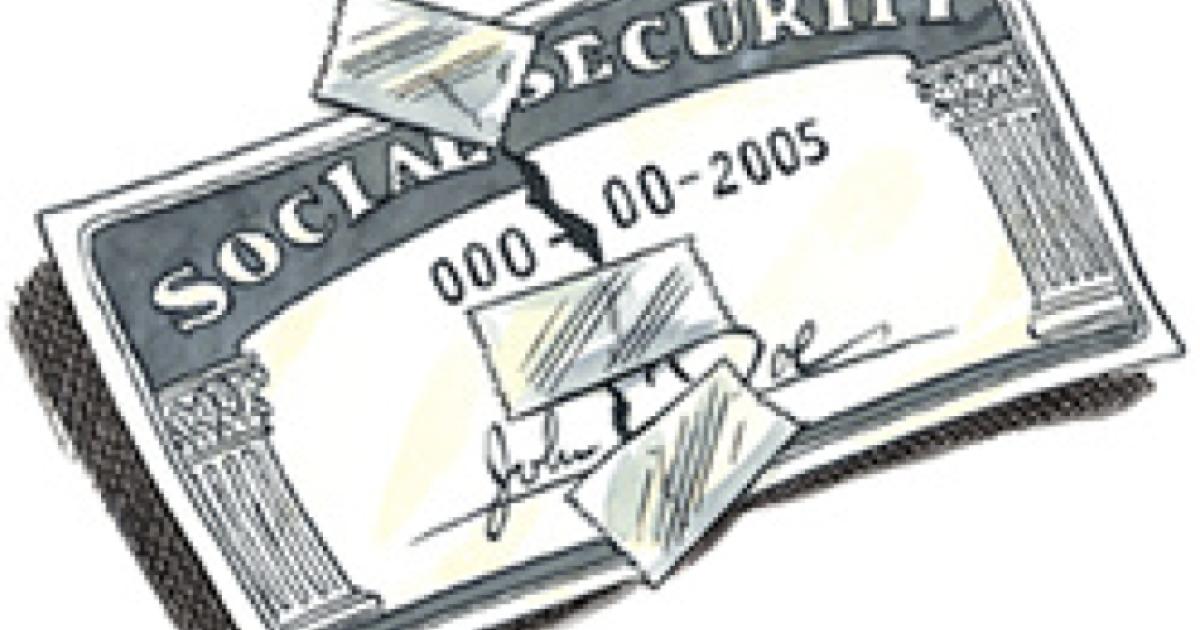- Budget & Spending
- Economics
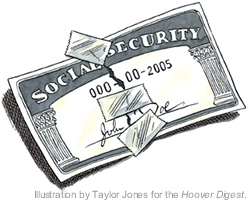
Republicans and Democrats are arguing passionately about the future of Social Security, and the argument, at its core, is about privatization. It is true, as some critics observe, that there is no magical gain in privatizing Social Security because all systems have to provide incomes for retired persons. By that token, however, there’s no gain in privatizing a government steel plant either because steel still has to be produced, too. Yet there are very good reasons—with roots in political economy—to privatize steel. And as with steel (and the like), there are excellent reasons for a privatized, individual account Social Security system.
Minimum Standard
Pay-as-you-go social security first started in Europe as a relatively easy way to provide a minimum standard of living for the elderly. It was introduced in the United States during the 1930s partly to discourage the elderly from competing for jobs when the unemployment of younger workers was staggeringly high. It was a cheap system then because there were more than 10 workers per retired person, so the Social Security tax was small relative to the benefits received by retirees. Indeed, the first several generations of retirees earned very high returns on their accumulated Social Security tax payments.
But birthrates have fallen drastically and life expectancy at age 60 has expanded enormously. Fewer workers are now being forced to support more and more retirees. The result is a huge rise in social security taxes in every nation with a pay-as-you-go system. The combined tax on employees and employers in the United States, excluding contributions to Medicare, is now 12.4 percent and rising; that percentage is much higher in Japan and most Western European nations. The expectation of continuing growth in this tax rate explains why countries such as Sweden and Britain have partially moved toward privatized, individual account systems. It also helps understand why Hong Kong, Poland, and other countries with low birthrates that recently introduced social security have important components of individual accounts in their systems.
Contrary to the Bush position, however, I do not believe that the main advantage of a private account system is that individuals can get a higher return on their old-age savings by investing in stocks. There are no freebies from such investments because the higher return on stocks is related to their greater risk and other trade-offs between stocks and different assets. Neither, however, is there any special “transition” problem in moving to a fully funded privatized system because future generations, under all systems, have to pay the implicit debt because of commitments to present and future retirees—unless, of course, they default on those commitments. But it is better to transit smoothly to fund this debt starting now, rather than require sharp increases in taxes on later generations.
Retirees for whom Social Security income is not a major part of their retirement assets will invest much of their own savings in stocks. Studies indicate that this is precisely what they generally do with their IRAs in order to have a balanced portfolio between stocks and the implicit Social Security assets guaranteed them. Because lower-income persons accumulate few assets other than Social Security, a fully funded system through personal savings would enable them to have portfolios more balanced between stocks and bonds.
Some might pose the question, If there is no obvious gain from allowing most individuals to invest in stocks to help cover their retirement, and if there is no fundamental transition problem, what, if any, are the advantages of a funded privatized system? I believe the advantages are mainly political, not “economic,” and that privatization helps separate saving for retirement from interest-group politics, from taxation, and from government spending.
Pay-as-you-go systems are in trouble in large part because of changes in the number of workers per retiree but also because of politically determined decisions that altered the system from a saving system for old age to an inefficient and complicated welfare system for some of the elderly. Despite the growing mental and physical health of older persons, political pressures in all nations with such systems forced a restructuring of social security payouts to encourage retirements at earlier ages than even the originally established 65. In the United States, many retirements occur at 62 or earlier, whereas Italians retire frequently in their mid-50s. Very early retirement is common in Germany, Belgium, and other European countries.
In addition, the link between contributions and benefits has been separated so that each additional dollar contributed in taxes pays no more than about 40 cents in additional benefits. Hence, the Social Security system has evolved into two largely independent systems: a sizable tax on wages, starting with the first dollar earned, and retirement benefits that are “guaranteed” by the government. There is only a modest link from an individual’s accumulated tax payments on his earnings to these “guarantees.”
Just as important are the political implications of federal fiscal behavior. Revenue from Social Security taxes at present exceeds payments to retirees. This excess is counted as part of the growing Social Security Trust Fund but in fact also enters into the consolidated federal budget account and helps reduce the reported spending deficit. Such deficits during the past decade would have been much larger if Social Security had not been running a surplus during this time.
Social Security tax revenues are expected to fall below spending on retirees in less than 20 years. If we simply raised Social Security taxes now—say by 2 percentage points—consolidated federal deficits would appear much smaller and the federal government would be under less constraint to reduce spending. Both theory and evidence indicate that a good fraction of the additional revenue would indeed be spent. “Putting aside” assets for the future is very difficult for all governments, subject as they are to immense demands for spending now from various interest groups.
A good individually funded savings system would require individuals to save 4 to 6 percent of their incomes (President Bush suggests 4 percent) and to invest these savings in private individual accounts that would meet certain government-established criteria. At the same time, Social Security taxes should be cut by a couple of percentage points from the present level to ease the burden on workers. These taxes could be cut because under this saving system younger workers would be contributing to their own retirement. Moreover, a tax cut would reduce the Social Security surplus so that the government would be less tempted to spend more by rapidly growing Social Security “reserves.”
These private accounts would accumulate tax free until individuals decide to retire. The age of retirement, within broad limits, would be left to individuals, but like IRAs now, these funds would continue to grow with savings for persons who retire at later ages because they like their work and are in good health. At retirement, individuals would get access to their assets either in a lump sum or as annualized income and would pay taxes on their withdrawals.
As in Chile and other countries with private retirement accounts, the government would guarantee retirees a minimum income—similar to, but larger than, the present minimum Social Security guarantee. Unfortunately, such guarantees create a “moral hazard”—that is, savers may want to make risky investments that give high payoffs if they succeed because the government partly bails them out. Or they may not save at all. But the minimum required savings rate overcomes the incentive to “game” the system, and regulating the types of investment accounts takes care of the incentive to take too many risks.
As in the president’s proposal, we should limit Social Security accounts to index funds—that is, funds that do not try to beat the market and that invest in a balanced market portfolio of stocks and bonds. Individuals who contribute more than the 4 percent minimum could take greater risks, as they do not pose any moral hazard. Index funds both reduce the overall risk of an account and have very low management fees because it is quite cheap to run these funds, as shown by Vanguard and Barclays, among others. High management fees are a common complaint about the Chilean system, although that system has yielded high returns to investors even net of these fees. Besides, the fees have come down a lot in recent years.
Privatized System
There is no guarantee that government interference would not increase further in such a privatized system because the retired would continue to press for additional benefits. But experience shows that governments interfere less when an industry is privatized, especially in access to capital and financing budget deficits.
Thus the strong arguments for privatization are that they reduce the role of government in determining retirement ages and incomes and improve government accounting of revenues and spending obligations. All the other issues are really diversions because neither advocates nor opponents of privatizing Social Security generally answer the most meaningful question: Is there as strong a political economy case for eliminating government management of the retirement industry as there is for eliminating its management of most other industries?
My answer is yes.








